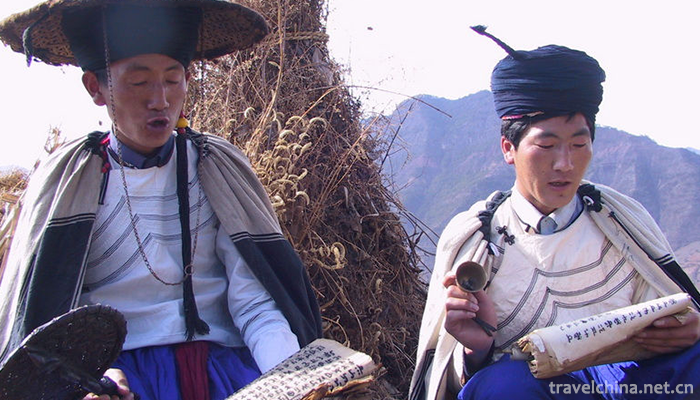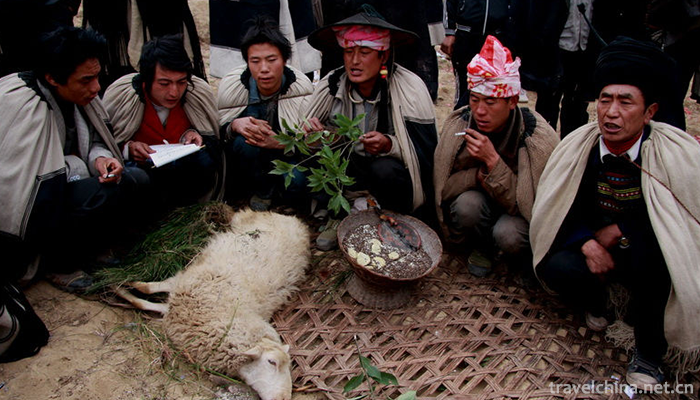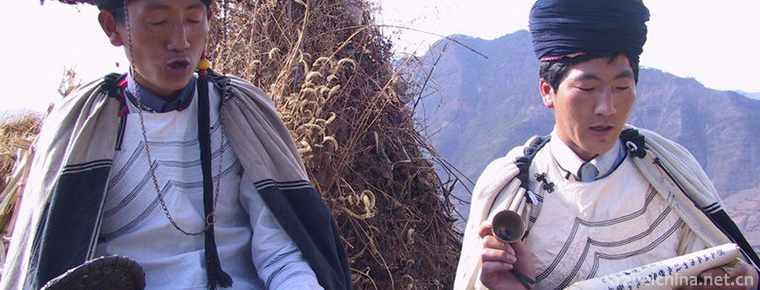Bemo music
Bemo music
Qubila fire is well known in Meigu County, Liangshan Prefecture. He is not only a highly respected Yi Dabimo, but also a representative successor of national intangible cultural heritage projects. His Bimo music is a combination of moral education, knowledge imparting and literary entertainment. Through symbolic and complicated rituals, it explores people's life thinking and promotes people's spiritual outlook.
In the early forties of this year, Qubila Huo was born in the Bimo family of Meigu. He studied and engaged in the traditional Bimo field of the Yi people for more than twenty years. Since he was 17 years old, he has been on the road of Bimo. Over the years, he has studied knowledge imparting and inheriting simultaneously, enriching his personal insights in the field of Bimo and Bimo music. He advocated Bimo music concept and personally presided over ceremonies in recent years are well known.
The first meeting with Qubila Fire was held in Meigu County in late December 2017 at the site of a national non-heritage project, the ritual of ancestor worship by Nimu Chobi of the Yi Nationality. In response to the reporter's questions, he systematically narrated the knowledge inheritance and connotation of Bimo music culture of the Yi nationality. He told reporters that Bimo music integrated the ancient language, writing, history, genealogy, astronomy, calendar, geography, folklore, ethics, literature and art of the Yi people. From its origin, development, prosperity to prosperity, it not only contributed to the convergence of the ideological field of the Yi people, but also penetrated into all aspects of the social life of the Yi people, with a far-reaching impact. "Encyclopedia" passed down from generation to generation.
It is understood that Bimo music is a kind of traditional music approved by the State Council in 2014 and listed in the fourth batch of national intangible cultural heritage list. Trabila fire was the representative inheritor of Bimo music in the provincial intangible cultural heritage project. Recently, among the representative successors of the fifth batch of national intangible cultural heritage projects announced by the Ministry of Culture, Qubila Huo ranked on the list and became the successor of Liangshan non-heritage "national name".
In an interview with reporters, Qubila Huo is doing the guiding link of the ritual of "Nimu Chobi" ancestor worship. He shows in detail the unique and essence of Bimo music. In Qubilahe's words, a "Guide to the Way" is a vivid picture of the migration of the ancestors of the Yi people, with the footprints of the Yi people's history permeating between the lines.




-
1.Dalian Jinshitan Scenic Area
Jinshitan is a national scenic spot, a national tourist resort, a national AAAAA scenic spot and a national geological park. It has been evaluated by CNN TV as one of the 40 most beautiful scenic spot
Time 2018-12-04 -
2.Tong li ancient town
Tongli Ancient Town belongs to Wujiang District, Suzhou City, Jiangsu Province. It was built in Song Dynasty. There are many gardens, temples, residences
Time 2018-12-06 -
3.Wushan small Three Gorges
The Little Three Gorges, or the Little Three Gorges Tourist Scenic Spot, was named "Forty Best Tourist Resorts in China" in 1991, "National AAAA Tourist Scenic Spot" in November 20
Time 2018-12-12 -
4.The Great Northern Wilderness Agricultural Expo
Beidahuang Agricultural Machinery Expo Park is a national AAAA-level tourist attraction located in Youyi County, 50 kilometers away from the city center, covering an area of 350,000 square meters.
Time 2018-12-26 -
5.High cavity
Gaoqiang is one of the four major tunes in Chinese opera. Gaoqiang was originally called "Yiyang Cavity" or "Yiqiang Cavity", because it originated in Yiyang, Jiangxi Province.
Time 2019-04-30 -
6.Hejian song poem
Hejian Song and Poetry, Hejian City, Hebei Province, local traditional folk literature, one of the national intangible cultural heritage.
Time 2019-05-02 -
7.Suzhou embroidery
Suzhou embroidery is the general name of embroidery products in Suzhou area. Its origin is in Wuxian, Suzhou. Now it has spread all over Wuxi, Changzhou and other places. Embroidery and silkworm reari
Time 2019-06-17 -
8.Shaoxing opera
Vietnam Opera is the second largest opera in China, known as the second national opera, also known as the "most widely circulated local opera". Some people think that it is the "largest
Time 2019-07-16 -
9.Guanyin Pavilion
Stand on Ezhou The city's Xiaodong gate dike overlooks the Yangtze River, and a huge reef stands in the center of the Yangtze River. Long pan Ji " It is also known as "Wanli Changjiang first
Time 2019-09-20 -
10.Daheishan Forest Park
Daheishan Forest Park is located in Wuben Township, Renhe District, Panzhihua City, Sichuan Province. From the center of Panzhihua bingcaogang River Panshan 58 kilometers, through Guaziping, Lanjian mine and Wuben township.
Time 2020-10-15 -
11.The announcer Ding Zhen will not be on duty until half a year later
On December 6, just after yesterday's live media broadcast, Ding Zhen met with more than 20 fans from all over the country to take photos at noon. Ding Zhen is no longer as shy and helpless as he was when he first met a stranger. After half a month's popularity,
Time 2020-12-06 -
12.Historical evolution of Neijiang
Xia and Shang were Liangzhou, Zhou was Yongzhou, spring and autumn and Warring States were ba Jun and Shu Jun; Western Han Dynasty was Zizhou; Eastern Han Dynasty was Han'an county.
Time 2020-12-16